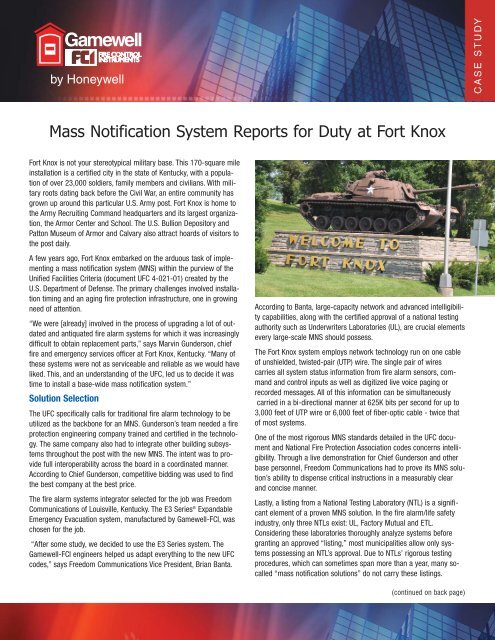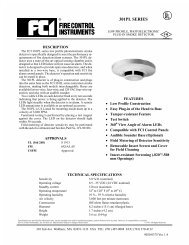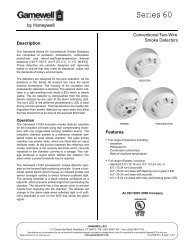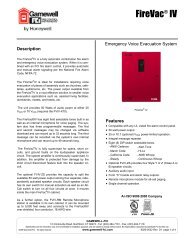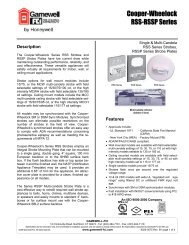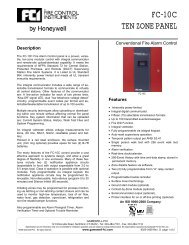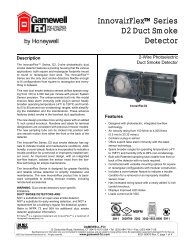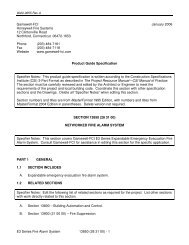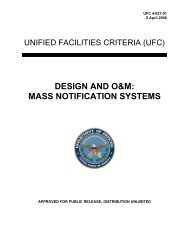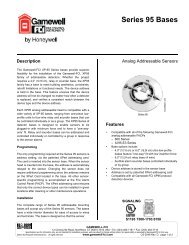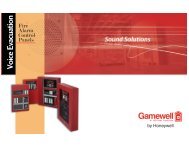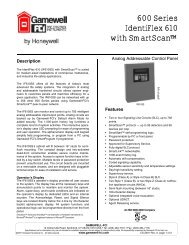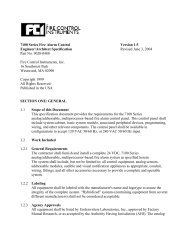Fort Knox - Gamewell-FCI
Fort Knox - Gamewell-FCI
Fort Knox - Gamewell-FCI
You also want an ePaper? Increase the reach of your titles
YUMPU automatically turns print PDFs into web optimized ePapers that Google loves.
CASE STUDYMass Notification System Reports for Duty at <strong>Fort</strong> <strong>Knox</strong><strong>Fort</strong> <strong>Knox</strong> is not your stereotypical military base. This 170-square mileinstallation is a certified city in the state of Kentucky, with a populationof over 23,000 soldiers, family members and civilians. With militaryroots dating back before the Civil War, an entire community hasgrown up around this particular U.S. Army post. <strong>Fort</strong> <strong>Knox</strong> is home tothe Army Recruiting Command headquarters and its largest organization,the Armor Center and School. The U.S. Bullion Depository andPatton Museum of Armor and Calvary also attract hoards of visitors tothe post daily.A few years ago, <strong>Fort</strong> <strong>Knox</strong> embarked on the arduous task of implementinga mass notification system (MNS) within the purview of theUnified Facilities Criteria (document UFC 4-021-01) created by theU.S. Department of Defense. The primary challenges involved installationtiming and an aging fire protection infrastructure, one in growingneed of attention.“We were [already] involved in the process of upgrading a lot of outdatedand antiquated fire alarm systems for which it was increasinglydifficult to obtain replacement parts,” says Marvin Gunderson, chieffire and emergency services officer at <strong>Fort</strong> <strong>Knox</strong>, Kentucky. “Many ofthese systems were not as serviceable and reliable as we would haveliked. This, and an understanding of the UFC, led us to decide it wastime to install a base-wide mass notification system.”Solution SelectionThe UFC specifically calls for traditional fire alarm technology to beutilized as the backbone for an MNS. Gunderson’s team needed a fireprotection engineering company trained and certified in the technology.The same company also had to integrate other building subsystemsthroughout the post with the new MNS. The intent was to providefull interoperability across the board in a coordinated manner.According to Chief Gunderson, competitive bidding was used to findthe best company at the best price.The fire alarm systems integrator selected for the job was FreedomCommunications of Louisville, Kentucky. The E3 Series ® ExpandableEmergency Evacuation system, manufactured by <strong>Gamewell</strong>-<strong>FCI</strong>, waschosen for the job.“After some study, we decided to use the E3 Series system. The<strong>Gamewell</strong>-<strong>FCI</strong> engineers helped us adapt everything to the new UFCcodes,” says Freedom Communications Vice President, Brian Banta.According to Banta, large-capacity network and advanced intelligibilitycapabilities, along with the certified approval of a national testingauthority such as Underwriters Laboratories (UL), are crucial elementsevery large-scale MNS should possess.The <strong>Fort</strong> <strong>Knox</strong> system employs network technology run on one cableof unshielded, twisted-pair (UTP) wire. The single pair of wirescarries all system status information from fire alarm sensors, commandand control inputs as well as digitized live voice paging orrecorded messages. All of this information can be simultaneouslycarried in a bi-directional manner at 625K bits per second for up to3,000 feet of UTP wire or 6,000 feet of fiber-optic cable - twice thatof most systems.One of the most rigorous MNS standards detailed in the UFC documentand National Fire Protection Association codes concerns intelligibility.Through a live demonstration for Chief Gunderson and otherbase personnel, Freedom Communications had to prove its MNS solution’sability to dispense critical instructions in a measurably clearand concise manner.Lastly, a listing from a National Testing Laboratory (NTL) is a significantelement of a proven MNS solution. In the fire alarm/life safetyindustry, only three NTLs exist: UL, Factory Mutual and ETL.Considering these laboratories thoroughly analyze systems beforegranting an approved “listing,” most municipalities allow only systemspossessing an NTL’s approval. Due to NTLs’ rigorous testingprocedures, which can sometimes span more than a year, many socalled“mass notification solutions” do not carry these listings.(continued on back page)
CASE STUDYSystem ComponentsMass notification systems consist of three basic components, as outlinedin the UFC:• Individual Building MNS – includes notification within all structuresas well as surrounding outdoor areas• Wide Area MNS – applies to all outdoor areas• Central Control Station – responsible for 24-hour monitoring of allMNS signals and emergency response communications“The facility MNS side of the project was relatively easy as we werealready installing fire alarm systems in all new and renovated buildings,”says Chief Gunderson. “These systems transmit alarm signals toa central receiving center (a.k.a. central monitoring station) locatedwithin the fire department. All we did was include the appropriate MNSspecifications for voice evacuation systems in all contracts.”The post’s individual building MNS was found to provide ample outdoorcoverage. Consequently, officials decided not to implement the widearea component at this time.“The facility’s 100-plus buildings’ mass notification systems have externalspeakers. This gives us good coverage within 100 feet of our criticalbuildings, which includes parking lots, walkways and smoking areas,”says Chief Gunderson. “We do have a high power speaker array, but it’sa separate, stand-alone system, as is the tornado warning system. Weare working towards integrating these into our mass notification systemso all systems integrate into one operating console.”Radio Telemetry NetworkTwo-way communications between individual building MNS and theCentral Control Station at <strong>Fort</strong> <strong>Knox</strong> is accomplished using an ultra-highfrequency (UHF) radio system. Established radio links are capable of fullsupervision, which enables trouble alerts to be sent locally when amaintenance issue develops within any building’s MNS or the radio systemitself.Providing background design and programming support for the <strong>Fort</strong><strong>Knox</strong> MNS was <strong>Gamewell</strong>-<strong>FCI</strong> Project Manager, Dick Aldrich. “Weworked with Freedom Communications to ensure this system performedthe required functions at the <strong>Fort</strong> <strong>Knox</strong> facility,” says Aldrich.“Interfacing the facility’s radio network with our E3 Series systemoffered big benefits. This integration provides bi-directional status andcontrol with one-way audio live voice paging and recorded messageselection and control.”At <strong>Fort</strong> <strong>Knox</strong>, integration with the E3 Series was accomplished usingelectromechanical relays, which allows totally dissimilar subsystems tocommunicate with one another. Integration can also be accomplishedthrough the development of firmware capable of interpreting the datafrom one system so it can be used by another.According to Aldrich, the base wide radio network system issues variouscommands by means of relay contact closures. The E3 Seriesbroadband system detects the individual relay commands and performsthe required functions as programmed by Freedom Communicationsusing the internal Boolean Logic or CAM (conditional action map) programmingcapability. The MNS functions include activation of visualindicators, pre-recorded audio tones and voice messages, and the mostimportant of all, base-wide live voice communications.Mike Tucker, a <strong>Fort</strong> <strong>Knox</strong> fire inspector and technician, indicated theradio system used was originally provided by the Department of theArmy. Although more than 25 years old, Tucker affirms it provides ahigh-tech means of networked communications.“We integrated it into our mass notification plans and procedures. Weare using two systems to provide the same data simultaneously -- onefor outside and another one for inside and close to each facility,” saysTucker.The use of radio technology has its advantages, which was realizedduring a major ice storm in the <strong>Fort</strong> <strong>Knox</strong> area during January 2009.Throughout the region, many aerial power and telephone lines collapsedunder the immense weight of several inches of ice. The use of radiotechnology helped to ensure critical information reached all personnelutilizing the local E3 Series systems’ MNS capability throughout thebase.“When the post initiated their relocation plan (during the ice storm) andset up shelters, we used the mass notification system to get out keymessages, such as shelter locations, emergency numbers and the like,”says Chief Gunderson. “This was a key tool in getting out pertinentemergency information during this crisis.”Part No. 9020-60588 0510 2K<strong>Gamewell</strong>-<strong>FCI</strong> • 12 Clintonville Road, Northford, CT 06472 • Tel 203-484-7161 Fax 203-484-7118 • www.gamewell-fci.com


